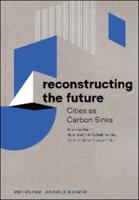Reconstructing the Future
Cities as Carbon Sinks
| dc.contributor.editor | Earth, Bauhaus | |
| dc.contributor.editor | Armillas Tiseyra, Rocío | |
| dc.contributor.editor | Schellnhuber, Hans Joachim | |
| dc.date.accessioned | 2023-07-06T13:06:11Z | |
| dc.date.available | 2023-07-06T13:06:11Z | |
| dc.date.issued | 2023 | |
| dc.identifier | ONIX_20230706_9783035627015_2 | |
| dc.identifier.uri | https://library.oapen.org/handle/20.500.12657/63841 | |
| dc.description.abstract | The built environment is a critical factor in the climate equation. Approximately 40 percent of global emissions derive from the construction, operation, and demolition of human settlements. The 21st century must be the century of re-entanglement, where quintessential functions (housing, work, culture, recreation, etc.) are reintegrated within urban spaces; where socioeconomic and ecological systems form a mutually supportive network of networks; and where past, present, and future are perceived as interwoven waves in the river of time. Fortunately, opportunities exist to transform the built environment from a carbon source to a carbon sink through, e.g. timber construction high-rise buildings, circular bioeconomy methods, AI-assisted design, smart recycling technology, multifunctional land use, integrated regional resource management, and community-based urban development, to name just a few. | |
| dc.language | English | |
| dc.subject.classification | thema EDItEUR::A The Arts::AM Architecture::AMD Architecture: professional practice | en_US |
| dc.subject.classification | thema EDItEUR::R Earth Sciences, Geography, Environment, Planning::RN The environment::RNP Pollution and threats to the environment::RNPG Climate change | en_US |
| dc.subject.classification | thema EDItEUR::R Earth Sciences, Geography, Environment, Planning::RN The environment::RNU Sustainability | en_US |
| dc.subject.classification | thema EDItEUR::T Technology, Engineering, Agriculture, Industrial processes::TN Civil engineering, surveying and building::TNK Building construction and materials | en_US |
| dc.subject.other | Architecture | |
| dc.subject.other | Sustainable Environment | |
| dc.subject.other | Planning | |
| dc.subject.other | Urban Design | |
| dc.subject.other | Erde | |
| dc.subject.other | Timber Construction | |
| dc.subject.other | AI-Design | |
| dc.subject.other | Mining | |
| dc.subject.other | Recycling | |
| dc.subject.other | Resource Management | |
| dc.title | Reconstructing the Future | |
| dc.title.alternative | Cities as Carbon Sinks | |
| dc.type | book | |
| oapen.identifier.doi | 10.1515/9783035627015 | |
| oapen.relation.isPublishedBy | 2b386f62-fc18-4108-bcf1-ade3ed4cf2f3 | |
| oapen.relation.isFundedBy | e81ff086-447f-4f16-bf00-d7534b621bf5 | |
| oapen.relation.isbn | 9783035627015 | |
| oapen.relation.isbn | 9783035626971 | |
| oapen.imprint | Birkhäuser | |
| oapen.pages | 248 | |
| oapen.place.publication | Berlin/Boston | |
| oapen.grant.number | [...] |

